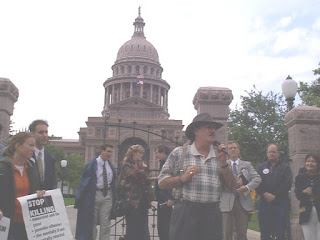 |
| Randall Dale Adams in 2001 Calling for a Moratorium on Executions in Texas |
It is now confirmed that Randall Dale Adams died October 30, 2010 in Ohio from a brain tumor at age 61. Condolences, memories and tributes can be left here.
Errol Morris tweeted yesterday on Twitter that Randall Dale Adams died in 2010. We have not yet confirmed Randall’s death. Randall Adams was an innocent person wrongfully convicted and sentenced to death in Texas. He was exonerated thanks to the film “The Thin Blue Line” by filmmaker Errol Morris.
In 2001, Randall Dale Adams testified to a committees in the Texas House and Senate and told his story of how he was wrongfully convicted and sentenced to Texas death row. His testimony helped convince the committees to vote in favor of a moratorium on executions. Later in 2001, 53 members of the Texas House voted for a moratorium on the floor of the Texas House in a bill filed by Rep Harold Dutton.
This year in 2011, the House Committee on Criminal Jurisprudence again considered a bill for a moratorium on executions, but the committee took no action on the bill. Maybe if the committee members had been able to hear from Randall Adams they would have voted for a moratorium.
Watch the beginning of “The Thin Blue Line” the documentary by Errol Morris that led to the exoneration of Randall Dale Adams, who at the time the film came out was still on death row in Texas.
Watch Errol Morris – The Thin Blue Line in Educational & How-To | View More Free Videos Online at Veoh.com
Listen to some music by Phillip Glass composed for the film “The Thin Blue Line”.







